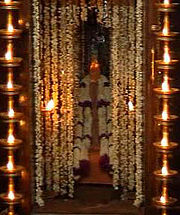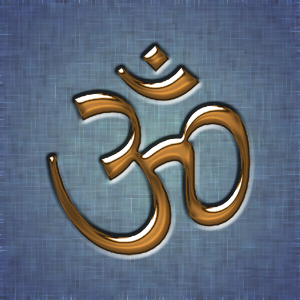
Lord Ayya Vaikundar, known to his followers as tenth avatar or incarnation of Lord Vishnu, also called as Sriman Narayana Vaikundasamy or Narayana Pandaram, was a 19th-century social reformer and iconoclast who worked for the upliftment of downtrodden people in the Kingdom of Travancore. He is central to the Hindu denomination of Ayyavazhi, as per holy scripture.

Ayyavazhi is a henotheistic belief that originated in South India. It is cited as an independent monistic religion by several newspapers, government reports, journals, and academic researchers. In Indian censuses, however, the majority of its followers declare themselves as Hindus. Thus, Ayyavazhi is also considered a Hindu denomination. Officially (legally), it exists within Hinduism as a Hindu denomination.

Akilathirattu Ammanai, also called Thiru Edu, is the main religious text of the Tamil belief system Ayyavazhi. The title is often abbreviated to Akilam or Akilathirattu.

Ambala Pathi, also called as Pallathu pathi or Moolakunda pathi is one of the primary pathi of the Ayyavazhi, and the second important pilgrim centers of Ayyavazhi, and the place where Ayya Vaikundar is said to have unified all divine power into himself by symbolic marriages.

Mutta Pathi, is one of the Pancha pathi, which are the primary centers for worship of the Ayyavazhi. This is the third important pilgrim center of Ayyavazhi. This place earn the religious importance in Akilam from the event that, Ayya Vaikundar is given two Vinchais here by Narayana under the Sea; One just before the arrest of Vaikundar by Swathi Thirunal and the second after the completion of Thuvayal Thavasu.

Sampooranathevan is a mythical figure found in Ayyavazhi mythology. He was considered a powerful Deva of Deiva Loga. In Kali Yuga, He was born, and became known in history as Mudisoodum Perumal or Muthukutty.

Ayyavazhi mythology is the mythology of the South Indian religious faith known as Ayyavazhi, which is officially considered a Hindu sect. The main source of Ayyavazhi mythology is the Ayyavazhi scripture, Akilathirattu Ammanai, and its supplement, Arul Nool. The Akilathirattu Ammanai is a recitation by Mayon to his consort Lakshmi. It is divided into three sections: Early Avatars, incarnational events and post-incarnational events.

Dharma Yukam is the state of absolute bliss as per Ayyavazhi mythology. Dharma Yukam is described in the Akilam seventeen in Akilathirattu Ammanai. It is related to Dharmic moksha and to Abrahamic heaven.

According to Akilattirattu Ammanai, for ten months, Ayya Vaikundar revealed to the people all about the past, present, and future in the form of songs. He sang definitively about the future. Some of those who heard him, took his words as meaningless mutterings. Vaikundar, realising that forbearance and fortitude were the essential virtues needed in his project of transforming the world, becalmed himself and performed the Tavam (Meditation). Having justice in his breath, the thought of mercy in his mind, and renouncing the desires of the body and containing the tendencies of his ego, Vaikundar performed the Tavam concentrating totally on the commands he had received from his father. His appearance was squalid, with holy ashes smeared on him, and the long unkempt hair flowing in the air.

The Ayya Vaikunda Avataram or Vaikunda Jayanthi is a festival celebrated by the followers of Ayyavazhi on the 20th day of the Tamil month of Masi, the date on which the Ayyavazhi followers believe that Lord Narayana himself incarnated as Vaikundar during an encounter with a deity Goddess Lakshmi, he was beget inside the sea and arose from the sea of Thiruchendur on Kollam Year 1008 at 20th day of Tamil Month Masi. He took the human form as Narayana Pantaram at Tharuvaiyur near seashore to destroy the evil spirit of Kali and transform the Kaliyukam into Dharma Yukam.
The following outline is provided as an overview and topic guide to Ayyavazhi:

Ayyavazhi theology is the theology of a South Indian religious Faith and officially a sect of Hinduism known as Ayyavazhi. Several fundamental theological beliefs distinguish the Ayyavazhi tradition from Hinduism.

Ayyavazhi and Hinduism are two belief systems in India. Although Ayyavazhi continues to officially exist within Hinduism and is considered by some observers to be a Hindu denomination, members of the religion claim that it is independent. The most notable distinction between Hinduism and Ayyavazhi is their different approaches to the concepts of good, evil and dharma.

The Ayyavazhi includes a corpus of teachings of its initiator Ayya Vaikundar in the form of instructions and slogans found in the religious book Akilattirattu.

According to the Ayyavazhi religion, the Ayyavazhi Trinity is the incarnation of God in the current stage of world development. Ayya Vaikundar, the Incarnation, is the combination of the Ultimate God, Narayana, and Human Being. In Akilam immediately after the Incarnation of Vaikundar, he was viewed simultaneously as the Ultimate God, Narayana, and as son of Narayana. As per the earlier deed Narayana had to destroy Kaliyan, but due to the boons that kaliyan claimed Narayana cannot destroy him. And as per the promise made by Kaliyan, he would only be destroyed, if he give torture to any Pantaram. To overcome all these, such a unique way of Incarnation was planned.

Akilam Five is the fifth section of Akilam, which is the primary scripture of Ayyavazhi. It narrates the cruel reign of Kaliyan, the death of two Santror and the subsequent curse given to Kali. It also hints about the start of the Kalineesan dynasty that tortured Vaikundar.

Muthiri Kinaru is the sacred well located in the north-western corner of Swamithoppe village. This is the famous theertha of the temple. It is located half a kilometre west from the main Pathi.

The Akilathirattu Ammanai the scripture of Ayyavazhi teaches Dharma on two different perspective. One in sociology as charity and truth and another under spirituality to attain the stage of Oneness, unified into Lord Vaikundar. This state of ultimate oneness is called as Dharma Yukam or Dharma Pathi. Akilam also says that, Dharma is the only living wheel. The sociological way is asked to be followed by every one to attain the spiritual state of Dharma.

The ethics of Ayyavazhi are found scattered throughout the primary scripture, Akilathirattu Ammanai. They are also integrated with the meta-narrative mythography. However, regarding ethics, Arul Nool is considered as an accumulation and prophecy of the core concepts found in Akilathirattu. In Akilathirattu, the ethical abstracts are pointed out as "told by God" at several places at different situations to lesser god-heads, devas, saints etc. when asked by them.

Ayyavazhi beliefs are those associated with the South Indian religious faith known as Ayyavazhi. Some of the beliefs of Ayyavazhi are shared with that of Hinduism, and others are unique to Ayyavazhi.




